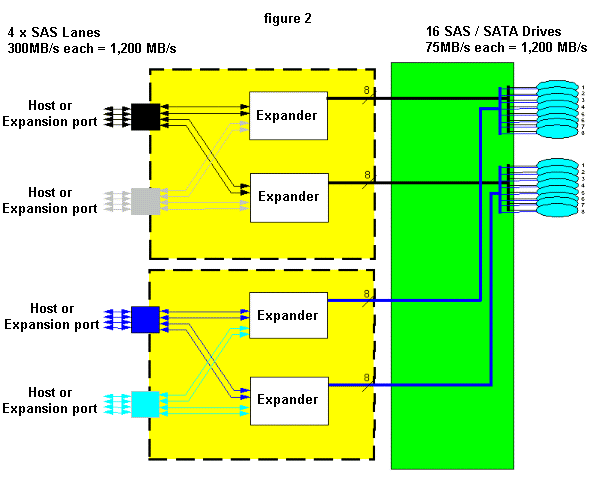|
|
|
|
|
|
|
| |||||||||
| Editor's intro:-This introduction to Serial Attached SCSI (published here in January 2005) gives you an idea of the performance, compatibilities, applications and roadmap for this new directly attached disk connection standard. With throughput capability faster than 2Gbps Fibre-channel systems and faster than ultra320 SCSI - the new SAS products not only provide an upward migration path for parallel SCSI applications but also open the door to a new class of high performance high reliability enterprise systems. | |||||||||
The Benefits of SAS (Serial Attached SCSI) for External Subsystems Serial Attached SCSI (SAS), the follow-on to parallel SCSI, is designed for high performance enterprise requirements and offers both the benefits of backward compatibility with SCSI and interoperability with Serial ATA (SATA), bringing enterprises a flexibility and cost savings previously not possible for traditional storage environments. SAS provides significant benefits to external storage subsystems and offers users "one-stop-shopping" to satisfy their requirements for the following three main data types. | |||||||||
| |||||||||
| An external subsystem with a
SAS midplane will support both high performance, reliable SAS drives ideal for
transaction data, and cost-effective, high capacity SATA drives ideal for
reference and throughput data, thus providing customers with one platform
instead of two to support both drive types and satisfy all three application
segments (illustrated in figure 1). SAS based external storage arrays provide
benefits in four areas: performance, availability, flexibility, scalability and
cost of ownership. Market Timing Because of its trusted reliability and stable feature set, the SCSI protocol has been accepted by the market for a remarkable twenty years. Introduced three years ago, Serial Attached SCSI (SAS) leverages this continuing evolution of SCSI with new levels of scalability, flexibility, and cost-effectiveness for connectivity, data transport, and data storage. The first SAS prototypes were announced in 2003 and were a major step to achieving mass market availability. Those prototypes allowed development of the first generation of technologies and products that will bring the benefits of SAS into the enterprise. These products have now been developed and tested, and a wide variety of integrated solutions have been demonstrated. Interoperability testing was a key component of SAS, because it increases the architecture's flexibility by supporting both SAS and Serial ATA (SATA) disk drives and components. Interoperability allows one vendor's SAS products to be compatible with another's, and it also ensures products developed today will work with all existing and next-generation SATA products. Interoperability testing was conducted throughout 2004, and the University of New Hampshire InterOperability Laboratory, successfully demonstrated all the required levels of interoperability in a variety of SAS products and configurations. The same companies that pioneered SCSI are investing in its evolution to maintain its high reliability standards while meeting the market's evolving technology and functionality requirements. Industry support comes from all of the major disk drive vendors, host adapter suppliers, chipset manufacturers, large computer makers, and many other suppliers. A wide variety of recent product and solution announcements have been made, with some product currently shipping. Others are expected to ship in early 2005 to make the long promise of SAS a reality. SAS subsystems are expected to ship in the first quarter of calendar 2005, and will coincide with the availability of SAS disk drives and SAS host bus adapters. Volume shipments will commence in the second quarter. Higher Performance SAS has received this kind of market attention due to several performance benefits. For example, a SAS connection can support four SAS wide lanes or 4 x 300 MB/s per connection. A SAS connection on a JBOD system can support a theoretical maximum of 1,200 MB/s (see figure 2). SAS is also used as a high performance, yet cost-effective expansion port to daisy chain to another SAS subsystem. | |||||||||
 | |||||||||
| In addition, each 3Gb high
performance SAS drive (10K rpm or 15K rpm) is connected to a 3Gb drive
connection, providing more then enough bandwidth for the highest performing
drives (see figure 2). Assuming 16 SAS drives in a subsystem and each drive
capable of 75 MB/s, that would equal 1,200 MB/s performance from 16 drives which
far surpasses both 2Gb Fibre Channel loops and U320 Parallel SCSI buses. The
roadmap for SAS is robust and provides clear investment protection by starting
at 3Gb, doubling to 6Gb in 2007 and then doubling again to 12Gb. Increased Availability Another benefit of SAS based storage subsystems is the native dual port capability of each SAS drive, providing a redundant path to each drive in the event of a controller failover. In addition, since each drive is on a separate point-to-point connection, losing a drive connection only affects a single drive compared to parallel SCSI in which losing a bus affects all the drives on the bus. SAS drives like Fibre Channel are designed for the rigors of enterprise use and heavy loads, have MTBF ratings in excess of 1 million hours and warranties up to 5 years. SAS drives are engineered for rugged enterprise duty, and every component (drive motor, spindle, actuator, firmware, etc.) is specifically designed and manufactured for that rigorous use. SAS drives also safeguard data integrity via their comprehensive verification/error correction capabilities. SAS (drive) based subsystems also support active-active controllers that failover, redundant host connections that could be SAS, Fibre Channel or iSCSI, redundant hot swappable power, cooling, and enclosure services and the same RAID and software capabilities found in Fibre Channel and SCSI based arrays. Utmost Flexibility Probably the best known benefit of SAS for external storage is its configuration flexibility. The ability to take a SATA drive and plug it into a SAS midplane without any modifications or changes, and for the controller in the array and software to seamlessly support a system with a mix of SATA and SAS. As illustrated in figure 3, 6 SAS drives could be partitioned in one storage pool or LUN and assigned to a server with a transaction intensive application such as a reservation system, and the other 6 drives be SATA and partitioned in a storage pool or LUN and assigned to a different server running a reference application such as medical imaging. Alternatively, one array could support all SAS drives and a second array connected or daisy chained to the first supporting all SATA drives. This flexibility is not possible with Fibre Channel and Parallel SCSI based subsystems providing customers with the best of both worlds. | |||||||||
 | |||||||||
| Seamless Scalability &
Improved Cost of Ownership
Unlike SCSI which has limitations in its architecture when trying to scale multiple drive enclosures, SAS provides the capability to scale greater than 100 drives or 36 TB with 300GB SAS drives or 48 TB with 400GB SATA drives providing very large pools of storage and a cost-effective alternative to Fibre Channel based SANs. SAS drives are expected to be priced on par with SCSI drives, and SAS implemented as a host interface and expansion interface on a RAID controller or JBOD I/O module will be less costly then Fibre Channel. In addition, supporting SAS and SATA drive types in one system reduces cost of ownership, simplifies training and product portfolios and provides investment protection. Summary Serial Attached SCSI will offer new levels of performance, availability and customer choice by supporting both enterprise-class Serial Attached SCSI drives and Serial ATA drives for cost-sensitive applications. OEMs and IT managers will have the flexibility to configure storage subsystems with either drive technology, or both, enabling high-performance and low-cost storage in the same subsystem thus maximizing customers' return on investment and providing flexibility for future growth. ...Adaptec profile | |||||||||
 | |||||||||
| Here are some other popular
articles which you may be interested in reading:-
SSD history the SSD bookmarks what's the state of DWPD? Surviving SSD sudden power loss Exiting the Astrological Age of Enterprise SSD Pricing latency reasons for fading out DRAM in the virtual memory mix | |||||||||
| . | ||||||
 | ||||||
| . | ||||||
| ||||||
| . | ||||||
| ||||||
. | ||||||
 |










